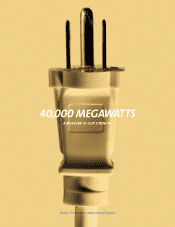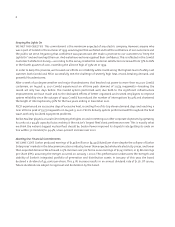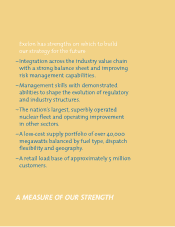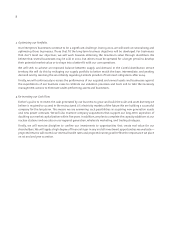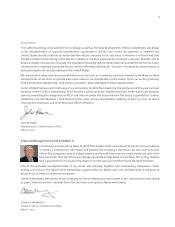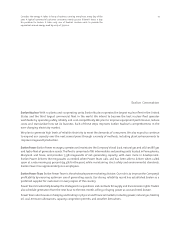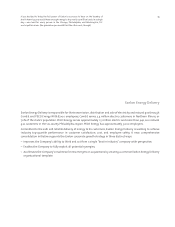ComEd 2001 Annual Report Download - page 7
Download and view the complete annual report
Please find page 7 of the 2001 ComEd annual report below. You can navigate through the pages in the report by either clicking on the pages listed below, or by using the keyword search tool below to find specific information within the annual report.
5
Growth
WE ARE WORKING AT IT When we announced the merger of our companies, we intended to grow EPS at 10% per-year
compounded through 2003. We exceeded this target in 2001 with a 15% EPS growth over 2000 pro forma EPS.
We believe we have created solid shareholder value through the PECO/Unicom merger of equals, our nuclear
acquisitions, the acquisition of 49.9% of Sithe, and the acquisition of the TXU plants. We also believe that we have
maintained shareholder value by saying “no” to potential acquisitions that came at too high a price—such as the
later nuclear plant auctions.
Unfortunately, we cannot currently project continued 10% growth over the next several years. The lower forward
electricity price curve, the downturn in the telecommunications industry, as well as the potential of a continued
economic slowdown and its effect on demand, all act to limit our growth expectations.
Exelon is still committed to growth—but will only invest in opportunities that appear likely to generate appropriate
returns. We have a strong earnings base from which investment in future cash-generating assets can be made and
believe we can reinforce this cash flow by the timely exit from some of our Enterprises investments.We will be patient
and diligent in our search for investment opportunities—and we will be ready when opportunities materialize.
The Future—What We Intend to Do.
Our Goals
Exelon’s near term goal, the next step in achieving our larger vision, is to become the largest, most consistently
profitable, integrated utility system in North America. We seek to expand our generation, power marketing, and
delivery positions in both the electric and gas sectors. We are building strong regional supply and demand positions
in the various North American power markets. The combination of serving retail load with our supply position and
Exelon’s marketing and trading capabilities provide opportunities to maximize the value of our generation assets
within acceptable levels of earnings volatility. We believe we can create superior shareholder value by achieving an
ever-higher level of operating excellence, a low-cost generation portfolio, and high levels of customer satisfaction.
Strong predictable cash flows will fund further growth.
Exelon Strengths
Exelon has the following strengths on which to build and implement our strategy for the future:
–Integration across the industry value chain with a strong balance sheet and improving risk management capabilities.
–Management skills with demonstrated abilities to shape the evolution of regulatory and industry structures.
–The nation’s largest, superbly operated nuclear fleet and operating improvement in other sectors.
–A low-cost supply portfolio of over 40,000 megawatts balanced by fuel type, dispatch flexibility and geography.
Our assets are located strategically in the Chicago, Philadelphia, Boston and Dallas/Fort Worth regions (4 of the 10
largest U.S. cities).
–A retail load base of approximately 5 million customers. These customers provide a reliable electric load to balance
our merchant exposure and the scale required for efficient retail and utility operations.

